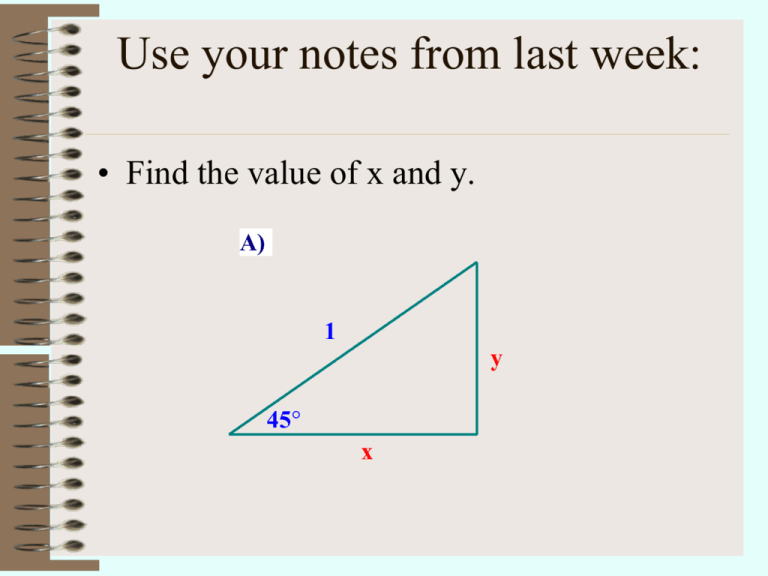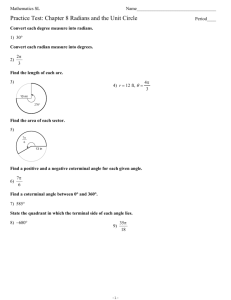
Use your notes from last week:
• Find the value of x and y.
A)
1
y
45°
x
Use your notes from last week:
• Find the value of x and y.
B)
1
30°
x
y
Use your notes from last week:
• Find the value of x and y.
c)
1
60°
x
y
Section 7-1 Measurement of
Angles
Objective: To find the measure of an
angle in either degrees or radians and
to find coterminal angles.
What we are going to learn in
Sec 7.1
•
•
•
•
•
Vocabulary
Angle measure in degrees and radians
Standard position
The critical values on the Unit Circle
Coterminal angles
Section 7-1 Measurement of
Angles
• Objective:
1. To find the measure of an angle in either
degrees or radians.
2. To find coterminal angles.
Common Terms
• Initial ray is the ray that an angle starts
from.
• Terminal ray is the ray that an angle ends
on.
• Vertex
Common Terms
• A revolution is one complete circular
motion.
Angles in standard position
y
x
Standard Position
Section 4.1, Figure 4.2, Standard
Position of an Angle, pg. 248
Vertex at origin
Copyright © Houghton Mifflin Company. All rights reserved.
The initial
side
Digital Figures,
4–3 of an angle
in standard position is always
located on the positive x-axis.
Angles in standard position
•
•
•
•
The vertex of the angle is on (0,0).
Initial ray starts on the positive x-axis
The angle is measure counter clockwise.
The terminal ray can be in any of the
quadrants.
Angle describes the amount and direction of rotation
120°
–210°
Positive Angle: rotates counter-clockwise (CCW)
Negative Angle: rotates clockwise (CW)
PositiveSection
and negative
angles4.3, Positive and
4.1, Figure
Negative Angles, pg. 248
When sketching angles,
always use an arrow to
show direction.
Copyright © Houghton Mifflin Company. All rights reserved.
13
Digital Figures, 4–4
Units of angle measurement
•
There are two ways to measure an angle:
Degrees
&
Radians
Units of angle measurement
• There are two ways to measure an angle:
Degree: 1/360th of a circle. That is the
measure one sees on a protractor and
most people are familiar with.
Angles can be further split into 60
minutes per degree and 60 seconds per
minute.
Quadrantal Angle
• If the terminal ray of an angle in standard
position lies along an axis the angle is
called a quadrantal angle.
• The measure of a quadrantal angle is
𝜋
always a multiple of 90°, or
2
Quadrantal angles
Standard Position
• When an angle is shown in a
coordinate plane, it usually
appears in standard position,
with its vertex at the origin and its
initial ray along the positive xaxis.
Degrees
On one of the circles provided measure 1°
Radian Measure
• Use the string provided to
measure the radius.
• Start on the “x-axis” and use the
string to measure an arc the
same length on the circle.
• The angle created is one radian.
Angle θ is
one radian
Units of angle measurement
Radian: when the arc of
circle has the same
length as the radius of
the circle. Angle a
measures 1 radian.
Arc Lenght=radius
1
radian
Radius
approximations
• 1 radian ~ 57.2958 degrees
• 1 degree ~ 0.0174533 radians*
• *note: the radian measure is usually stated
as a fraction of .
Sec 7.1 day 2
Warm up
• While I check your UC, work on the following:
a) Display the measure of one radian on circle.
Display the measure of two radians on a cirlce.
b) Describe what one radian is in terms of the
radius of a circle r.
c) Draw a circle and identify a central angle.
Describe relationship between central angle
and the intercepting arc.
Find the measure of the central angle
𝟏
𝟐
The central angle shown has a measure of radian.
What is the length of arc 𝑪𝑫?
Find the measure of the central
angle COH
Length CGH = 4 cm
Measure of central angle:
• For radian measure:
s
r
s= arc length
r= radius
For degree measure:
180 s
r
Section 4.1, Figure 4.7, Common
Radian Measure
Radian Angles, pg. 249
30
Working with Radians
1
180
180°
1 𝑟𝑎𝑑𝑖𝑎𝑛 =
𝜋
The conversion process
• When converting between the two units of
angle measurement, start with the
following template:
𝜋
𝑟𝑎𝑑𝑖𝑎𝑛
=
180° 𝐷𝑒𝑔𝑟𝑒𝑒
Example 1
Convert 196° to radians
𝜋
𝑟𝑎𝑑𝑖𝑎𝑛
=
180° 𝐷𝑒𝑔𝑟𝑒𝑒
𝜋
𝑟𝑎𝑑𝑖𝑎𝑛
=
180°
196°
Radian measure
196
is= 𝜋
180
=
49
𝜋
45
Convert
2
𝜋
3
to degrees.
𝜋
𝑟𝑎𝑑𝑖𝑎𝑛
=
180° 𝐷𝑒𝑔𝑟𝑒𝑒
2
𝜋
𝜋
3
=
180°
𝑥
2
180° × 𝜋
3
= 120°
𝑥=
𝜋
Calculator
• 2nd APP (Angle)
• Use DMS to convert to Degree, minute and
second.
• Use Angle to change 40° 20’ to a decimal
value.
• For more information click here
Coterminal angles
• Two angles in standard position are called
coterminal angles if they have the same
terminal ray.
• For any given angle there infinitely many
coterminal angles.
Example
• Find two angles, one positive and one
negative, that are coterminal with the angle
52°. Sketch all three angles
Solution
• 52 + 360 = 412
• 52 + 360 × 2 = 772
• 52 + 360 × 3 = 1132
• 52 − 360 = −308
• 52 − 360 × 2 = −668
• 52 − 360 × 3 = −1028
Example
• Find two angles, one positive and one
negative, that are coterminal with the
angle
4
•Sketch all three angles.
y
Coterminal Angles generalized:
• Degree measure: θ 360°n
• Radian measure: θ 2π n
• Where n is a counting number.
Helpful websites
• Trig flash cards
• http://mathmistakes.info/facts/TrigFacts/
• Hot math flash cards:
• http://hotmath.com/learning_activities/inter
activities/trig_flashcard.swf
Homework
• Sec 7.1 Written Exercises
• Problems # 1-8 all and
• # 9-29 odds
• UC with coordinates filled out.
1 degree = 60 minutes
1 minute = 60 seconds
1° = 60
1 = 60
3600
So … 1 degree = _________seconds
Express 365010as decimal degrees
36
50
60
10
3600
36 + .8333 + .00277
36.8361
OR
Use your calculator!!
Express 365010as
decimal degrees
Enter 36
Press this button ’ ’’
Press enter
Enter 50
Press this button ’ ’’
Go over to the ’
symbol -- enter
Enter 10
Press this button ’ ’’
Go over to the ’’
symbol -- enter
Press enter
Convert 50 47’ 50’’ to decimal degree
50.7972
Convert 125 27’ 6’’ to decimal degree
125.4517
Can you go backwards and convert the decimal degree to
degrees minutes seconds?
Enter 125.4517 Go to DMS hit enter.
Express 50.525 in degrees, minutes, seconds
50º + .525(60)
50º + 36.5
50º + 36 + .5(60)
50 degrees, 36 minutes, 30 seconds






